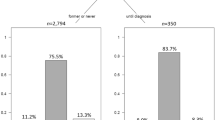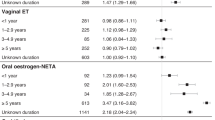Abstract
Background
The purpose of this study was to investigate the characteristics of breast cancer in hormone replacement therapy (HRT) users vs. nonusers.
Methods
We investigated the characteristics of all patients between the ages of 50 and 75 years with breast tumors. Then, an age-adjusted group of 55 nonusers was chosen to match and compare with HRT users.
Results
Of the 243 patients available for evaluation, 55 (22.6%) used HRT. Disease stages in HRT users vs. nonusers were as follows: ductal carcinoma in situ (DCIS), 20% and 17.1%; stage I, 45.5% and 41.7%; stage II, 30.9% and 26.2%; stage III, 3.6% and 13.4%; and stage IV, 0% and 1.6% (P=.27). In the age-adjusted cohort, stages in nonusers were as follows: DCIS, 7.3%; stage I, 47.3%; stage II, 25.5%; stage III, 20%; and stage IV, 0% (P=.03). Tumor grades in HRT users vs. nonusers were as follows: grade I, 30.4% and 15.7%; grade II, 52.2% and 52.2%; and grade III, 17.4% and 32.1% (P=.035). Grades in cohort nonusers were as follows: I, 13.2%; II, 52.8%; and III, 34% (P=.05). In the invasive tumors, the positive estrogen receptor (ER) rates were 81.6% and 85.7% (P=.89); positive progesterone receptor (PR) rates were 53.1% and 54% (P=.95); and Her 85.7% (P=.89); positive progesterone receptor (PR) rates were 53.1% and 54% (P=.95); and Her 2-neu positive rates were 18.4% and 17.6% (P=.95), respectively. No significant difference was found in intratumor DCIS, vascular invasion, and Ki-67 (P=.14, .9, and .79, respectively). The rate to lobular and favorable histological types was higher in the HRT user group: 26.6% vs. 15%.
Conclusions
Breast tumors in HRT users vs. nonusers were of a significantly lower stage and grade and accounted for a higher number of favorable histological types, but all other parameters were similar in the two groups.
Similar content being viewed by others
References
Morrisey DR, Kirchner JT. Management of the climacteric.Postgrad Med 2000;108:85–100.
Brett KM, Madans JH. Use of postmenopausal hormone-replacement therapy: estimates from a nationally representative cohort study,Am J Epidemiol 1997;145:536–44.
Moorhead T, Hannaford P, Warskyi M. Prevalence and characteristics associated with the use of hormone-replacement therapy in Brain.Br J Obstet Gynaecol 1997;104:290–7.
Kaplan B, Aschkenazi-Steinberg S, Yogev Y, Nahum R, Sulkes J, Phisher M. Gynecologists' trends and attitudes toward prescribing hormone replacement therapy during menopause.Menopause 2002;9:354–9.
Smith DC, Prentice R, Thompson DJ, Hermann WL. Association of exogenous estrogen and endometrial cancer.N Engl J Med 1975;293:1164–7.
Marsden J. Hormone replacement therapy and breast cancer.Lancet Oncol 2002;3:303–11.
Strickland DM, Gambrell RD Jr, Butzin CA, Strickland K. The relationship between breast cancer survival and prior postmenopausal estrogen use.Obstet Gynecol 1992;80:400–4.
Palmer JR, Rosenberg L, Clake EA, Miller DR, Shapiro S. Breast cancer risk after estrogen replacement therapy: Results from the Toronto breast cancer study.Am J Epidemiol 1991;134:1386–95.
La Vecchia C, Negri E, Franceschi S, et al. Hormone replacement treatment and breast cancer risk: a cooperative Italian study.Br J Cancer 1995;72:244–8.
Newcomb PA, Longnecker MP, Storer BE, et al. Long-term hormone replacement therapy and the risk of breast cancer in postmenopausal women.Am J Epidemiol 1995;142:788–95.
Sellers TA, Mink PJ, Cerhan JR, et al. The role of hormone replacement therapy in the risk of breast cancer and total mortality in women with a family history of breast cancer.Ann Intern Med 1997;127:973–80.
Collaborative Group on Hormonal Factors for Breast Cancer. Breast cancer and hormone replacement therapy. Collaborative reanalysis from 51 individual epidemiological studies.Lancet 1997;350:1047–60.
Colditz GA, Hankinson SE, Hunter DJ, et al. The use of estrogens and progestins and the risk of breast cancer in postmenopausal women.N Engl J Med 1995;332:1589–93.
Schairer C, Lubin J, Troisi R, Brinton L, Hoover R. Menopausal estrogen and estrogen-progestin replacement therapy and breast cancer risk.JAMA 2000;283:485–91.
Writing Group for the Women's Health Initiative Investigators. Risks and benefits of estrogen plus progestin in healthy postmenopausal women. Principal results from the women's health initiative randomized controlled trial.JAMA 2002;288:321–33.
Chen CL, Weiss NS, Newcomb P, Barlow W, White E. Hormone replacement therapy in relation to breast cancer.JAMA 2002;287:734–41.
Willis DB, Calle EE, Miracle McMahil H, Heath CW. Estrogen replacement therapy and risk of fatal breast cancer in a prospective cohort of postmenopausal women in the United States.Cancer Causes Control 1996;7:449–57.
Harding C, Knox WF, Faragher EB, Baildam A, Bundred NJ. Hormone replacement therapy and tumor grade in breast cancer: prospective study in screening unit.BMJ 1996;312:1646–7.
Holli K, Isola J, Cuzik, J. Low biologic aggressiveness in breast cancer in women using hormone replacement therapy.J Clin Oncol 1998;16:3115–20.
Sacchini V, Zurrida S, Andreoni G, et al. Pathologic and biological prognostic factors in short- and long-term hormone replacement therapy users.Ann Surg Oncol 2002;9:266–71.
Rosen PP, Oberman HA.Tumors of the Mammary Gland. Washington, DC: Armed Forces Institute of Pathology, 1993.
Green FL, Page DL, Fleming ID, et al. The breast. In:AJCC Cancer Staging Manual. 6th ed. Heidelberg: Springer-Verlag, 2002:221–40.
Elston CW, Ellis IO. Pathological prognostic factors in breast cancer: the value of histological grade in breast cancer.Histopathology 1991;19:403–10.
Cheek J, Lacy J, Toth-Fejel S, Morris K, Calhoun C, Pommier R. The impact of hormone replacement therapy on the detection and stage of breast cancer.Arch Surg 2002;137:1015–21.
Delgado RC, Lopez DML. Prognosis of breast cancer detected in women receiving hormone replacement therapy.Maturitas 2001; 38:147–56.
Gajdos C, Tartter P, Babinzki A. Breast cancer diagnosed during hormone replacement therapy.Obstet Gynecol 2000;95:513–8.
Merom D, Ifrah A, Cohen-Manheim I, Chinich A, Green MS. Factors predicting current use of hormone replacement therapy among menopausal Jewish women in Israel: the National Women's Health Interview Survey, 1998.IMAJ 2002;4:671–6.
Bonnier P, Bessenay F, Sasco AJ, et al. Impact of menopausal hormone-replacement therapy on clinical and laboratory characteristics of breast Cancer.Int J Cancer 1998;79:278–82.
Magnusson C, Holmberg L, Norden T, Lindgren A, Persson I. Prognostic characteristics in breast cancers after hormone replacement therapy.Breast Cancer Res Treat 1996;38:325–34.
Li CI, Weiss NS, Stanford JL, Daling JR. Hormone replacement therapy in relation to risk of lobular and ductal breast carcinoma in middle-aged women.Cancer 2000;88:2570–7.
Daling JR, Malone KE, Doody DR, et al. Relation of reginens of combined hormone replacement therapy to lobular, ductal, and other histologic types of breast carcinoma.Cancer 2002;95:2455–64.
Gapstur SM, Morrow M, Sellers TA. Hormone replacement therapy and the risk of breast cancer with a favorable histology.JAMA 1999;281:2091–7.
Knight WA, Livingstone RB, Gregory EJ, McGuire WL. Estrogen receptor as an independent prognostic factor for early recurrence in breast cancer.Cancer Res 1977;37:4669–71.
Peters GN, Fodera T, Sabol J, Jones S, Euhus D. Estrogen replacement therapy after breast cancer: a 12-year follow-up.Ann Surg Oncol 2001;8:828–32.
Lawson JS, Field AS, Tran DD, Houssami N. Hormone replacement therapy use dramatically increases breast oestrogen receptor expression in obese postmenopausal women.Breast Cancer Res 2001;3:342–5.
Fabian CJ, Kimler BF, McKittrick R, et al. Recruitment with high physiological doses of estradiol preceding chemotherapy: flow cytometric and therapeutic results in women with locally advanced breast cancers—a Southwest Oncology Group study.Cancer Res 1994;54:5357–62.
Cobleigh MA, Norlock FE, Oleske DM, Starr A. Hormone replacement therapy and high S phase in breast cancer.JAMA 1999;281:1528–30.
Hynes NE, Stern DF. The biology of ErbB-2/neu/HER-2 and its role in cancer.Biochim Biophys Acta 1994;1198:165–84.
Chrysogelos SA, Dickson RB. EGF receptor expression, regulation and function in breast cancer.Breast Cancer Res Treat 1994;29:29–40.
Nanda K, Bastian LA, Schultz K. Hormone replacement therapy and the risk of death from breast cancer: a systematic review.Am J Obstet Gynecol 2002;186:325–34.
Grodstein F, Stampfer MJ, Colditz G, et al. Postmenopausal hormone therapy and mortality.N Engl J Med 1997;336:1769–76.
Ursin G, Tseng CC, Paganini-Hill, et al. Does menopausal hormone replacement therapy interact with known factors to increase risk of breast cancer?J Clin Oncol 2002;20:699–706.
Author information
Authors and Affiliations
Corresponding author
Rights and permissions
About this article
Cite this article
Pappo, I., Meirshon, I., Karni, T. et al. The characteristics of malignant breast tumors in hormone replacement therapy users versus nonusers. Annals of Surgical Oncology 11, 52–58 (2004). https://doi.org/10.1007/BF02524346
Received:
Accepted:
Issue Date:
DOI: https://doi.org/10.1007/BF02524346




